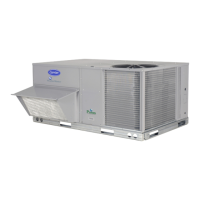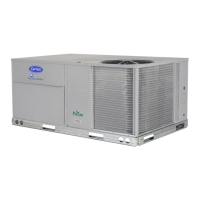17
Step 9 — Install Flue Hood
Flue hood is shipped screwed to the basepan beside the burner
compartment access panel. Remove from shipping location and
using screws provided, install flue hood and screen in location
shown in Fig. 17. Insert the flue hood’s side flange through the
access panel cutout, then rotate the flue hood until the top and
bottom flanges contact the outside of the access panel; secure
flue hood with screws.
Fig. 17 — Flue Hood Details
Step 10 — Install Gas Piping
Installation of the gas piping must be accordance with local
building codes and with applicable national codes. In U.S.A.,
refer to NFPA 54/ANSI Z223.1 National Fuel Gas Code
(NFGC). In Canada, installation must be in accordance with
the CAN/CSA B149.1 and CAN/CSA B149.2 installation
codes for gas burning appliances.
This unit is factory equipped for use with Natural Gas fuel at ele-
vations up to 2000 ft (610 m) above sea level. Unit may be field
converted for operation at elevations above 2000 ft (610 m) and/or
for use with liquefied petroleum fuel. See accessory kit installation
instructions regarding these accessories.
NOTE: Furnace gas input rate on rating plate is for installation
up to 2000 ft (610 m) above sea level. The input rating for alti-
tudes above 2000 ft (610 m) must be derated by 4% for each
1000 ft (305 m) above sea level.
For natural gas applications, gas pressure at unit gas connection
must not be less than 4 in. wg (996 Pa) or greater than 13 in. wg
(3240 Pa) while the unit is operating. For liquefied petroleum ap-
plications, the gas pressure must not be less than 11 in. wg
(2740 Pa) or greater than 13 in. wg (3240 Pa) at the unit connec-
tion. See Tables 3 and 4.
Table 3 — Natural Gas Supply Line Pressure Ranges
Table 4 — Liquid Propane Supply Line Pressure
Ranges
The gas supply pipe enters the unit at the burner access panel
on the front side of the unit, through the long slot at the bottom
of the access panel. The gas connection to the unit is made to
the
1
/
2
-in. or
3
/
4
-in. FPT gas inlet port on the unit gas valve.
Manifold pressure is factory-adjusted for NG fuel use. Adjust
as required to obtain best flame characteristics. See Tables 5
and 6.
Table 5 — Natural Gas Manifold Pressure Ranges
NOTE: LOW FIRE, 1.7 in. wg (423 Pa), applies to the following units
only: 48HCD/E/F*07, 48HCD*08 and 48HCD*09.
Manifold pressure for LP fuel use must be adjusted to specified
range. Follow instructions in the accessory kit to make initial
readjustment.
Table 6 — Liquid Propane Manifold Pressure Ranges
NOTE: LOW FIRE, 5.0 in. wg (1420 Pa), applies to the following units
only: 48HCD/E/F*07, 48HCD*08 and 48HCD*09.
Install a gas supply line that runs to the unit heating section.
Refer to the NFPA 54/NFGC or equivalent code for gas pipe
sizing data. Do not use a pipe smaller than the size specified.
Size the gas supply line to allow for a maximum pressure drop
of 0.5-in. wg (124 Pa) between gas regulator source and unit
gas valve connection when unit is operating at high-fire flow
rate.
The gas supply line can approach the unit in three ways: hori-
zontally from outside the unit (across the roof), thru-curb/under
unit basepan (accessory kit required) or through unit basepan
(factory option or accessory kit required). Consult accessory
kit installation instructions for details on these installation
methods. Observe clearance to gas line components per
Fig. 18.
Fig. 18 — Gas Piping Guide (with Accessory Thru-
the-Curb Service Connections)
UNIT MODEL UNIT SIZE MIN MAX
48HCD/E/F
07, 08, 09, 11,
12
4.0 in. wg
(996 Pa)
13.0 in. wg
(3240 Pa)
UNIT MODEL UNIT SIZE MIN MAX
48HCD/E/F
07, 08, 09, 11,
12
11.0 in. wg
(2740 Pa)
13.0 in. wg
(3240 Pa)
BLOWER
ACCESS
PANEL
FLUE OPENING
UNIT MODEL UNIT SIZE HIGH FIRE LOW FIRE
48HCD/E/F
07, 08, 09, 11,
12
3.5 in. wg
(872 Pa)
2.0 in. wg
(498 Pa)
UNIT MODEL UNIT SIZE HIGH FIRE LOW FIRE
48HCD/E/F
07, 08, 09, 11,
12
10.0 in. wg
(2490 Pa)
5.7 in. wg
(1420 Pa)
CAUTION
EQUIPMENT DAMAGE HAZARD
Failure to follow this caution may result in damage to
equipment.
When connecting the gas line to the unit gas valve, the
installer MUST use a backup wrench to prevent damage
to the valve.
STEEL PIPE NOMINAL
DIAMETER (in.)
SPACING OF SUPPORTS X
DIMENSION (ft)
1/2 6
3/4 or 1 8
1 1/4 or larger 10
LEGEND
NFGC — National Fuel Gas
Code
* Field supplied.
NOTE: Follow all local codes.
X
BASE UNIT
BASE RAIL
ROOF
CURB
9” MINIMUM CLEARANCE
FOR PANEL REMOVAL
MANUAL GAS
SHUTOFF VALVE
*
GAS
REGULATOR
*
48” MINIMUM
DRIP LEG
PER NFGC
*
FIELD-FABRICATED
SUPPORT
*
FROM
GAS
METER

